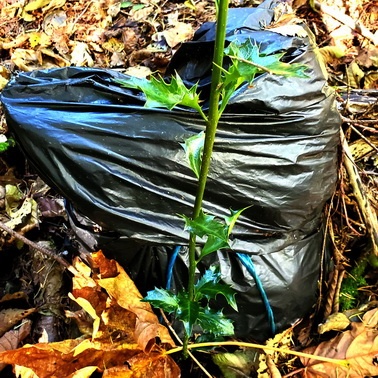The Persistence of English Holly
I once came across a large English Holly growing on its side. Someone had cut it down and left it lying where it fell, its trunk hanging in the air and its branches pressed to the ground. Some of these branches had sprouted roots and, amazingly, the whole tree was growing happily on its side, seemingly unfazed, as though nothing could stop it!
English Holly is all too common, invasive, and persistent in Puget Sound area forests. Sometimes I find it as a single tree, but it often expands into thickets through its robust ability to spread by layering. Lower branches grow out, sag down until they touch the ground, and sprout roots. Then, with the support of this new root system, the branches bend upward toward the light and eventually become new trunks. The process repeats itself, and little by little a single Holly tree becomes a thicket.
Controlling English Holly
If a Holly tree is too large to pull or dig out, I usually go ahead and cut it down, careful to put it on a compost heap where the branches cannot reach the ground and grow roots. What remains is a living stump, from which the plant will grow back within a few years, if I don’t return annually to clip off new basal shoots. It may take years of this, but eventually the tree will starve. An alternative for Holly trees, recommended by several sources, including King County, is the “cut-stump treatment” using herbicides.
Black Plastic Wrap
Forest restoration volunteers on public lands are usually not allowed to use herbicides, so as an experiment, several years ago, I cut down a large Holly and wrapped the stump in several layers of black plastic — snug to the ground — securing the wrap with some cord. My idea was to block out all the light reaching the stump to prevent basal shoots. The experiment was a partial success. When I checked recently only one basal shoot had managed to emerge from under the wrap. Next time I try this, I will make sure the plastic wrap extends deeper into the soil. This method is not pretty to look at, but if you are working on public land or adverse to using herbicides in your backyard, you might give it a try to combat the persistence of Holly.
